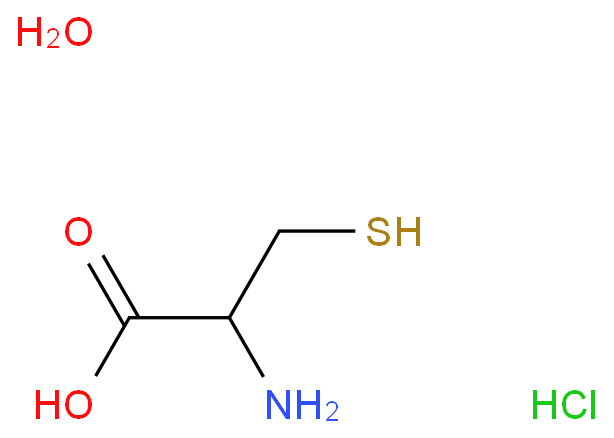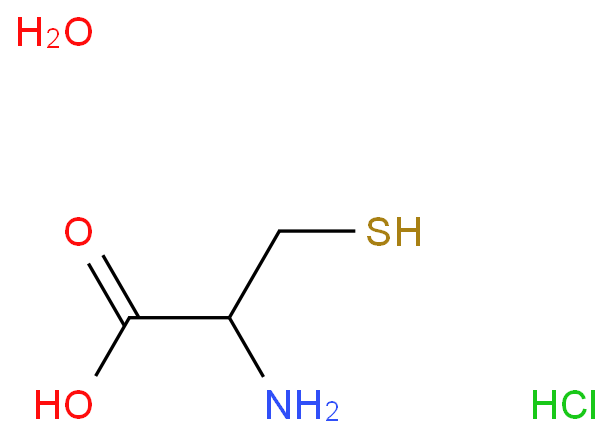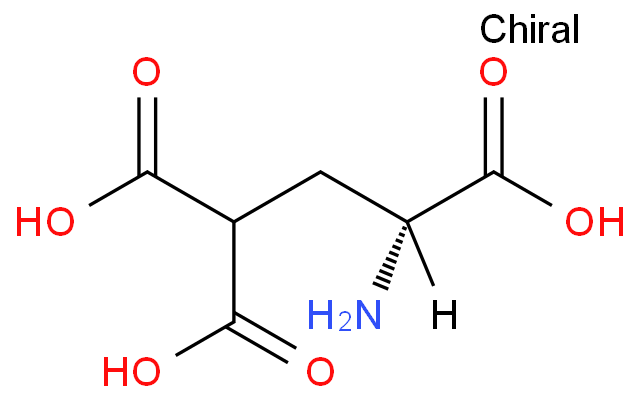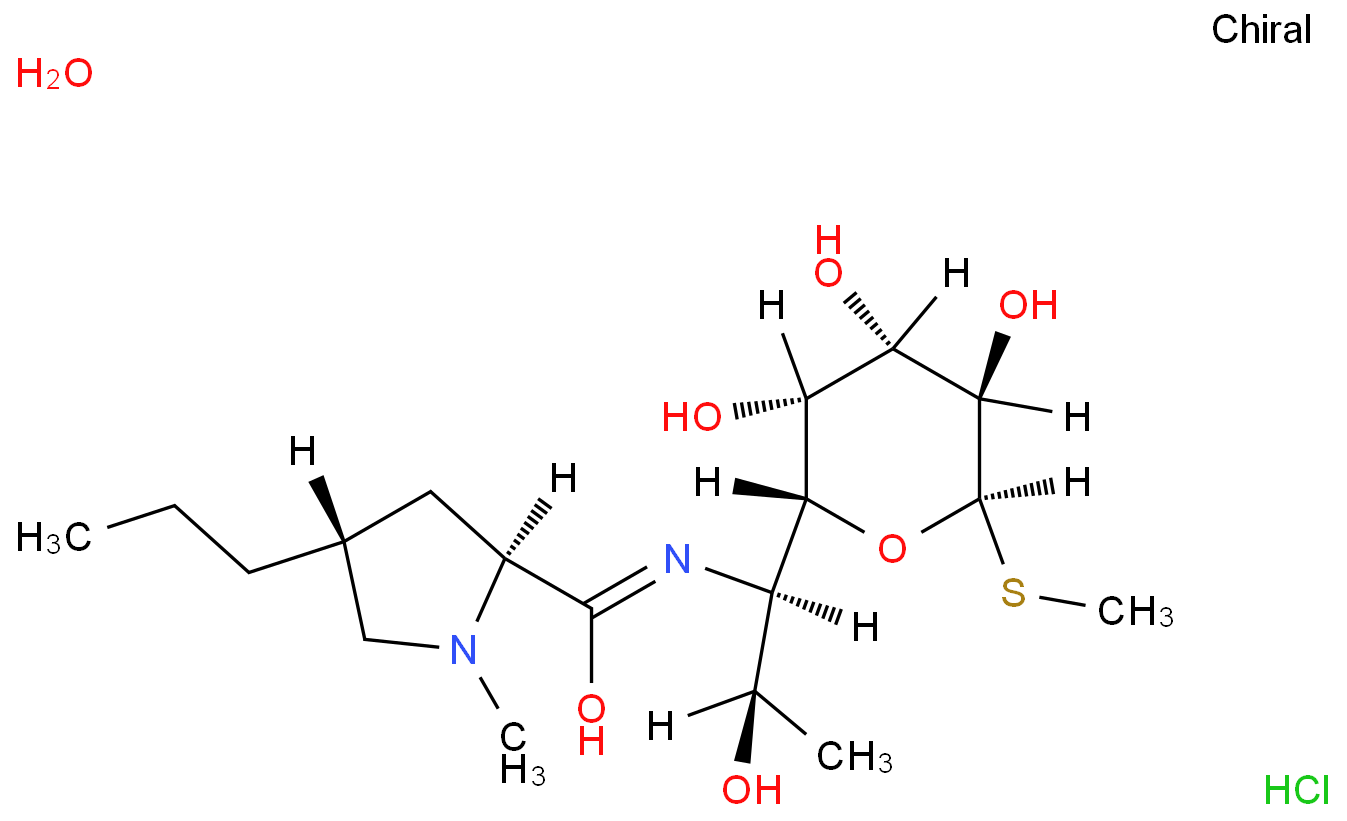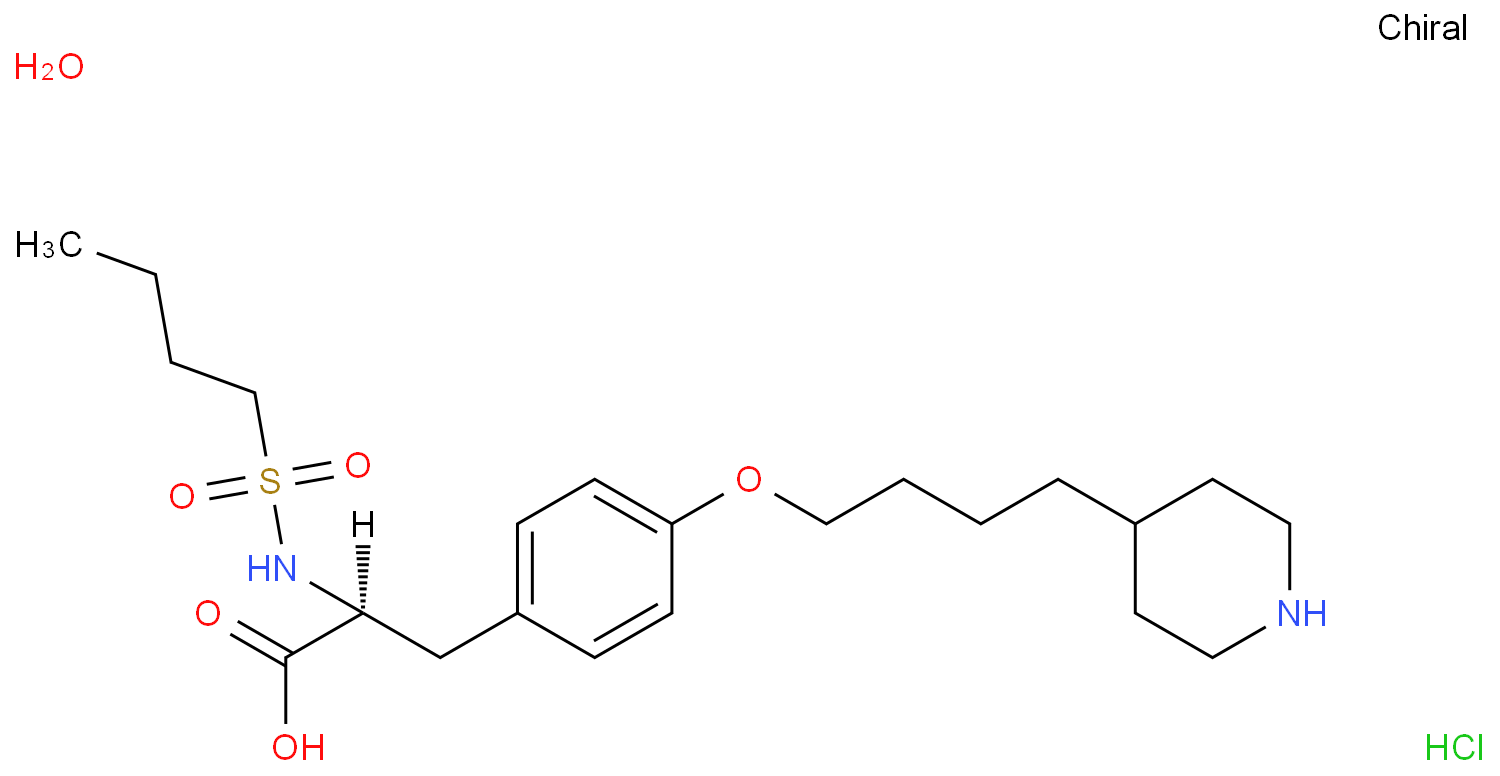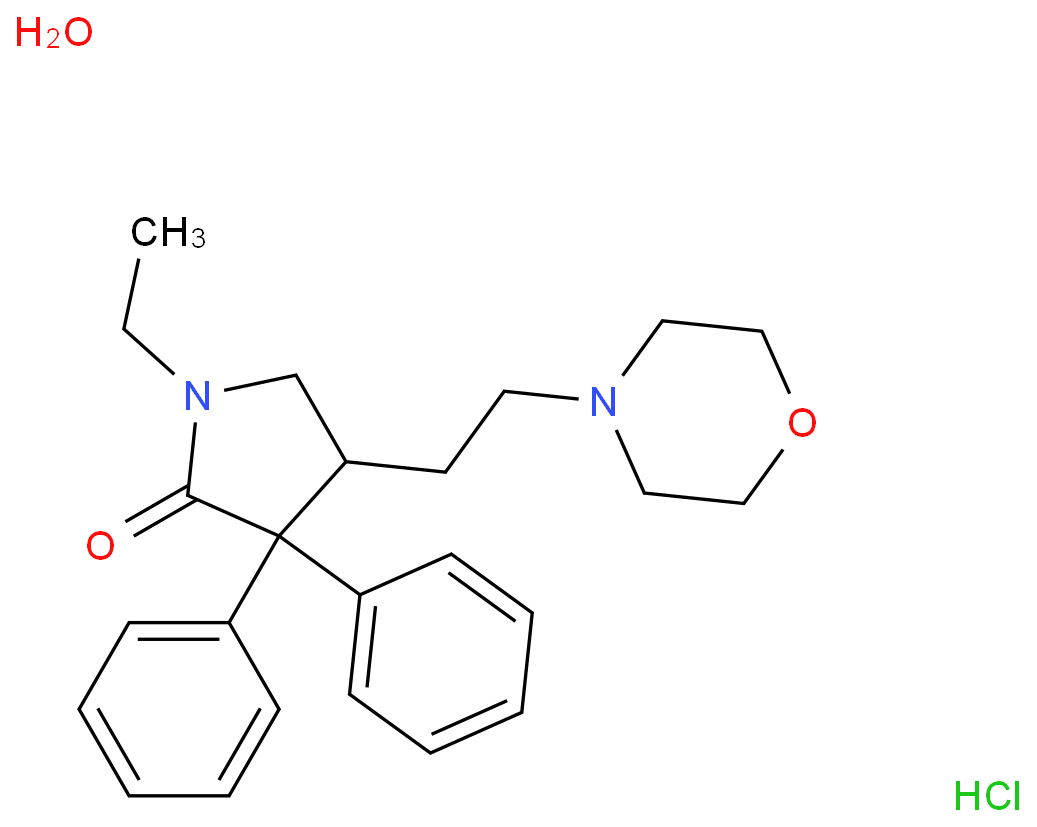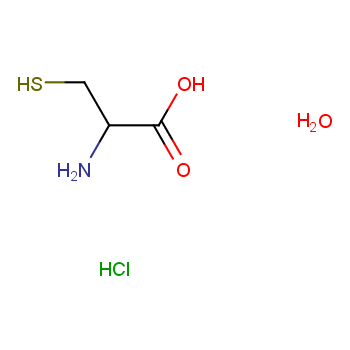 |
L-Cysteine hydrochloride monohydrate
- Iupac Name:(2R)-2-amino-3-sulfanylpropanoic acid;hydrate;hydrochloride
- CAS No.: 7048-04-6
- Molecular Weight:121.15818
- Modify Date.: 2022-11-29 03:26
- Introduction: L-Cysteine hydrochloride monohydrate, with the chemical formula C3H10ClNO3S and CAS registry number 7048-04-6, is a compound used in various applications such as food additives, pharmaceuticals, and biochemical research. This compound is derived from the amino acid cysteine and is commonly utilized in protein synthesis. L-Cysteine hydrochloride monohydrate is known for its role as a precursor in the production of flavors and fragrances due to its characteristic sulfur-containing functional group. L-Cysteine is a non-essential amino acid that can be synthesized by the human body under normal physiological conditions if a sufficient quantity of methionine is available. L-Cysteine is commonly used as a precursor in the food and pharmaceutical industries. L-Cysteine is used as a processing aid for baking, as an additive in cigarettes, as well as in the preparation of meat flavours. Additionally, it serves as a reducing agent in certain chemical reactions. This white crystalline solid is soluble in water and has been investigated for its potential antioxidant properties. It is an important compound in biotechnology and organic synthesis, contributing to the development of various products in the food and pharmaceutical industries.
View more+
1. Names and Identifiers
- 1.1 Name
- L-Cysteine hydrochloride monohydrate
- 1.2 Synonyms
(+-)-cis-2-amino-cyclopentanol,hydrochloride (1R)-1-Carboxy-2-sulfanylethanaminium chloride hydrate (1:1:1) (1R,2S)-2-aMinocyclopentan-1-ol hydrochloride (1R,2S)-CIS-2-AMINOCYCLOPENTANOL HYDROCHLORIDE (2R)-2-Amino-3-sulfanylpropanoic acid hydrate hydrochloride (R)-(+)-CYSTEINE HYDROCHLORIDE HYDRATE (R)-2-Amino-3-mercaptopropanoic acid hydrochloride hydrate (R)-cysteine hydrochloride monohydrate 3-MERCAPTO-2-AMINOPROPIONIC ACID HYDROCHLORIDE 3-MERCAPTO-2-AMINOPROPIONIC ACID HYDROCHLORIDE MONOHYDRATE CYSTEINE HCL H2O CYSTEINE HYDROCHLORIDE MONOHYDRATE CYSTEINI HYDROCHLORIDUM MONOHYDRICUM D,L-cis-2-Aminocyclopentanol-Hydrochlorid D,L-cysteine hydrochloride monohydrate EINECS 200-157-7 H-CYS-OH HCL H2O H-Cys-OH·HCl·H2O H-Cys-OH.HCl.H2O H-L-CYS-OH HCL H2O L-(+)-cysteine hydrochloride hydrate L-cysteine HCl monohydrate L-Cysteine Hydrochloride L-Cysteine hydrochloride hydrate L-cysteine monohydrate hydrochloride L-Cysteine monohydrate monochloride L-cysteine monohydrochloride monohydrate L-Cysteine, hydrochloride, hydrate (1:1:1) L-Cysteinehydrochloridemonohydrate MFCD00065606 SH1YZVQ &&HCl H2O Trans-(1R,2S)-2-Aminocyclopentanol Hydrochloride
- View all
- 1.3 CAS No.
- 7048-04-6
- 1.4 CID
- 23462
- 1.5 EINECS(EC#)
- 200-157-7
- 1.6 Molecular Formula
- C3H10ClNO3S (isomer)
- 1.7 Inchi
- InChI=1S/C3H7NO2S.ClH.H2O/c4-2(1-7)3(5)6;;/h2,7H,1,4H2,(H,5,6);1H;1H2/t2-;;/m0../s1
- 1.8 InChIkey
- QIJRTFXNRTXDIP-JIZZDEOASA-N
- 1.9 Canonical Smiles
- C(C(C(=O)O)N)S.O.Cl
- 1.10 Isomers Smiles
- C([C@@H](C(=O)O)N)S.O.Cl
2. Properties
- 2.1 Density
- 1.54 g/cm3
- 2.1 Melting point
- 175°C
- 2.1 Boiling point
- 293.9 oC at 760 mmHg
- 2.1 Refractive index
- 6 ° (C=8, 1mol/L HCl)
- 2.1 Flash Point
- 131.5 oC
- 2.1 Precise Quality
- 175.00700
- 2.1 PSA
- 111.35000
- 2.1 logP
- 0.76610
- 2.1 Solubility
- H2O: 1?M at?20?°C, clear, colorless
- 2.2 Appearance
- White Solid
- 2.3 Storage
- Store at RT.
- 2.4 Chemical Properties
- white crystalline powder
- 2.5 Color/Form
- Colorless crystals
White crystals
- 2.6 PH
- 0.8-1.2 (100g/l, H2O, 20℃)
- 2.7 Water Solubility
- H2O: 1?M at?20?°C, clear, colorless
- 2.8 Spectral Properties
- Specific optical rotation: + 6.5 deg @ 25 deg C/D (5 N HCl); +13.0 deg @ 25 deg C/D (glacial acetic acid)
Specific optical rotation: +9.7 deg C (c=8 in 1M HCL) @ 25 deg C/D
MASS: NIST 63547 (NIST/EPA/MCDC Mass Spectral Database 1990 version)
IR: SADP 13419 (Sadtler Research Laboratories IR prism collection)
UV: OES 2-10 (Phillip et al; Organic Electronic Spectral Data. NT, NY: John Wiley and Sons)
1H NMR: SAD 16992 (Sadtler Research Laboratories spectral collection)
- 2.9 Stability
- Stable. Incompatible with strong oxidizing agents, most common metals, hydrogen chloride.
- 2.10 StorageTemp
- Keep in dark place,Inert atmosphere,Room temperature
3. Use and Manufacturing
- 3.1 Definition
- ChEBI: A hydrate that is the monohydrate form of L-cysteine hydrochloride.
- 3.2 Methods of Manufacturing
- Hydrolyze the hair with hydrochloric acid for 6-8 hours, distill off the hydrochloric acid under reduced pressure, decolorize with activated carbon, and filter. The filtrate is neutralized with ammonia to obtain crude L-cystine crystals, and then recrystallized with ammonia to obtain L-cystine.?Using L-cystine as raw material, L-cysteine ??can be obtained through reduction, and there are two methods.?Tin particle reduction method.?Dissolve L-cystine in dilute hydrochloric acid, add tin particles and raise the temperature to reflux for 2h, filter out the remaining tin particles in the reducing solution, dilute with water, and then saturate with hydrogen sulfide; filter, and filter residue washed with a small amount of water ; Combine washing solution and filtrate, concentrate under reduced pressure, cool and crystallize, separate, and dry to obtain L-cysteine ??hydrochloride.?HOOCCH(NH2)CH2SSCH2CH(NH2)COOH+Sn[HCl, H2S→HSCH2CH(NH2)COOH·CHl electrolytic reduction method L-cystine and dilute hydrochloric acid are added to the electrolytic cell, stirred and dissolved, and electrolyzed at 50 ℃; electrolysis The solution is saturated with hydrogen sulfide for several hours; filtered, the filtrate is decolorized with activated carbon, the decolorized liquid is concentrated under reduced pressure, cooled and crystallized, separated and dried to obtain L-cysteine ??hydrochloride, and the consumption of cystine is 0.7t per ton of product , Hydrochloric acid 1t.?HOOCCH(NH2)CH2SSCH2CH(NH2)COOH+HCl→HSCH2CH(NH2)COOH·CHl
- View all
- 3.3 Purification Methods
- Likely impurities are cystine and tyrosine. Crystallise the salt from MeOH by adding diethyl ether, or from hot 20% HCl. Dry it under vacuum over P2O5. Hygroscopic. [Beilstein 4 III 1580, 1600.] L-Cysteine hydrochloride monohydrate Preparation Products And Raw materials Preparation Products
- 3.4 Usage
- L-Cysteine is a non-essential amino acid that can be synthesized by the human body under normal physiological conditions if a sufficient quantity of methionine is available. L-Cysteine is commonly used as a precursor in the food and pharmaceutical industries. L-Cysteine is used as a processing aid for baking, as an additive in cigarettes, as well as in the preparation of meat flavours.
4. Safety and Handling
- 4.1 Hazard Codes
- Xi
- 4.1 Risk Statements
- R36/37/38
- 4.1 Safety Statements
- S26
- 4.1 Exposure Standards and Regulations
- Cysteine used as a nutrient and/or dietary supplement in animal drugs, feeds, and related products is generally recognized as safe when used in accordance with good manufacturing or feeding practice.
Substance added directly to human food affirmed as generally recognized as safe (GRAS).
L-Cysteine is a food additive permitted for direct addition to food for human consumption, as long as 1) the quantity of the substance added to food does not exceed the amount reasonably required to accomplish its intended physical, nutritive, or other technical effect in food, and 2) any substance intended for use in or on food is of appropriate food grade and is prepared and handled as a food ingredient.
- 4.2 Octanol/Water Partition Coefficient
- log Kow = -2.49
- 4.3 Hazard Declaration
- H315
- 4.3 DisposalMethods
- SRP: At the time of review, criteria for land treatment or burial (sanitary landfill) disposal practices are subject to significant revision. Prior to implementing land disposal of waste residue (including waste sludge), consult with environmental regulatory agencies for guidance on acceptable disposal practices.
- 4.4 RIDADR
- NONH for all modes of transport
- 4.4 Caution Statement
- P261, P264, P271, P280, P302+P352, P304+P340, P305+P351+P338, P312, P321, P332+P313, P337+P313, P362, P403+P233, P405, P501
- 4.4 Formulations/Preparations
- ...occurs naturally in the L(+) form. ... Available commercially as L(+)-cysteine hydrochloride.
- 4.5 WGK Germany
- 3
- 4.5 RTECS
- HA2285000
- 4.5 Safety
- Hazard Codes:Xi
Risk Statements:36/37/38
36/37/38:Irritating to eyes, respiratory system and skin
Safety Statements:26-36
26:In case of contact with eyes, rinse immediately with plenty
of water and seek medical advice
36:Wear suitable protective clothing
WGK Germany:3
HS Code:29309013
- 4.6 Sensitive
- Hygroscopic
- 4.7 Specification
-
white crystalline powder
Safety Statements:26-36
26:In case of contact with eyes, rinse immediately with plenty
of water and seek medical advice
36:Wear suitable protective clothing
5. MSDS
2.Hazard identification
2.1 Classification of the substance or mixture
Skin irritation, Category 2
Eye irritation, Category 2
Specific target organ toxicity \u2013 single exposure, Category 3
2.2 GHS label elements, including precautionary statements
| Pictogram(s) |  |
| Signal word | Warning |
| Hazard statement(s) | H315 Causes skin irritation H319 Causes serious eye irritation H335 May cause respiratory irritation |
| Precautionary statement(s) | |
| Prevention | P264 Wash ... thoroughly after handling. P280 Wear protective gloves/protective clothing/eye protection/face protection. P261 Avoid breathing dust/fume/gas/mist/vapours/spray. P271 Use only outdoors or in a well-ventilated area. |
| Response | P302+P352 IF ON SKIN: Wash with plenty of water/... P321 Specific treatment (see ... on this label). P332+P313 If skin irritation occurs: Get medical advice/attention. P362+P364 Take off contaminated clothing and wash it before reuse. P305+P351+P338 IF IN EYES: Rinse cautiously with water for several minutes. Remove contact lenses, if present and easy to do. Continue rinsing. P337+P313 If eye irritation persists: Get medical advice/attention. P304+P340 IF INHALED: Remove person to fresh air and keep comfortable for breathing. P312 Call a POISON CENTER/doctor/\u2026if you feel unwell. |
| Storage | P403+P233 Store in a well-ventilated place. Keep container tightly closed. P405 Store locked up. |
| Disposal | P501 Dispose of contents/container to ... |
2.3 Other hazards which do not result in classification
none
6. Other Information
- 6.0 Usage
- L-Cysteine hydrochloride monohydrate is used as a precursor in food, pharmaceutical and personal care products. It is actively involved in the production of flavors such as meat flavor obtained by reacting with sugars. It plays an important role as a key raw material for the manufacture of N-acetyl-L-cysteine, S-carboxymethyl-L-cysteine and L-cysteine base. It is involved in the treatment of liver disease as an antioxidant and antidote. Being an essential amino acid, it used as animal feed especially for sheep, which is responsible the growth of wool.
- 6.1 Merck
- 14,2781
- 6.2 BRN
- 5158059
- 6.3 Application
-
L-cysteine ??hydrochloride monohydrate has been used in protocols to isolate dorsal root ganglion neurons (DRG). It was also used in research to test its effect as an inhibitor of enzymatic browning of apples.
- 6.4 General descriptio
-
L-cysteine ??hydrochloride monohydrate (LCHCMH) is a water-soluble salt of the non-essential amino acid L-cysteine. It is widely used in the pharmaceutical industry. The thermodynamic characteristics of LCHCMH in aqueous solution have been reported. [1] It can be crystallized in an orthogonal system with the P212121 space group. Its nonlinear optical (NLO) characteristics have been studied in single crystals grown by unidirectional Sankaranarayanan-Ramasamy (SR) technology.
- 6.5 Chemical Properties
-
white crystalline powder

- 6.6 Uses
- L-Cysteine is a non-essential amino acid that can be synthesized by the human body under normal physiological conditions if a sufficient quantity of methionine is available. L-Cysteine is commonly use d as a precursor in the food and pharmaceutical industries. L-Cysteine is used as a processing aid for baking, as an additive in cigarettes, as well as in the preparation of meat flavours.
- 6.7 Uses
-
L-Cysteine hydrochloride monohydrate has been used as a component of yeast dropout media for culturing yeasts. It has also been used as a component of differential reinforced clostridial broth (DRCM) for the isolation of clostridia.
- 6.8 Storage Conditions
- Hydrolyze the hair with hydrochloric acid for 6-8 hours, distill off the hydrochloric acid under reduced pressure, decolorize with activated carbon, and filter. The filtrate is neutralized with ammonia to obtain crude L-cystine crystals, and then recrystallized with ammonia to obtain L-cystine.?Using L-cystine as raw material, L-cysteine ??can be obtained through reduction, and there are two methods.?Tin particle reduction method.?Dissolve L-cystine in dilute hydrochloric acid, add tin particles and raise the temperature to reflux for 2h, filter out the remaining tin particles in the reducing solution, dilute with water, and then saturate with hydrogen sulfide; filter, and filter residue washed with a small amount of water ; Combine washing solution and filtrate, concentrate under reduced pressure, cool and crystallize, separate, and dry to obtain L-cysteine ??hydrochloride.?HOOCCH(NH2)CH2SSCH2CH(NH2)COOH+Sn[HCl, H2S→HSCH2CH(NH2)COOH·CHl electrolytic reduction method L-cystine and dilute hydrochloric acid are added to the electrolytic cell, stirred and dissolved, and electrolyzed at 50 ℃; electrolysis The solution is saturated with hydrogen sulfide for several hours; filtered, the filtrate is decolorized with activated carbon, the decolorized liquid is concentrated under reduced pressure, cooled and crystallized, separated and dried to obtain L-cysteine ??hydrochloride, and the consumption of cystine is 0.7t per ton of product , Hydrochloric acid 1t.?HOOCCH(NH2)CH2SSCH2CH(NH2)COOH+HCl→HSCH2CH(NH2)COOH·CHl
- View all
- 6.9 Use Classification
- Cosmetics -> Antioxidant; Reducing
7. Computational chemical data
- Molecular Weight: 121.15818g/mol
- Molecular Formula: C3H10ClNO3S
- Compound Is Canonicalized: True
- XLogP3-AA: null
- Exact Mass: 175.0069920
- Monoisotopic Mass: 175.0069920
- Complexity: 75.3
- Rotatable Bond Count: 2
- Hydrogen Bond Donor Count: 5
- Hydrogen Bond Acceptor Count: 5
- Topological Polar Surface Area: 65.3
- Heavy Atom Count: 9
- Defined Atom Stereocenter Count: 1
- Undefined Atom Stereocenter Count: 0
- Defined Bond Stereocenter Count: 0
- Undefined Bond Stereocenter Count: 0
- Isotope Atom Count: 0
- Covalently-Bonded Unit Count: 3
- CACTVS Substructure Key Fingerprint: AAADccBCMABEAAAAAAAAAAAAAAAAAAAAAAAAAAAAAAAAAAAAAAAAHgQQCAAACCjFwASACABAAgQIAACQCAAAAAAAAAAAAIGAAAACAAAAAAAAQAAAEAAAAAAAAAAAAAAAAAAAAAAAAAAAAAAAAAAAAAAAAA==
8. Question & Answer
-
L-Cysteine is a key substance with physiological effects that is widely found in nature. It is a carbohydrate used by cells in animal and plant bodies to defend against harmful substances and enhance ..
9. Recommended Suppliers
-
- Products:UVT-150/OCTOCRYLENE/UV3039/Pirfenidone,Letrozole,IPTG,DL-Homocysteinethiolactone hydrochloride,Tris Base,Cyclopropylboronic Acid,L-Carnosine,L-Cysteine,D(+)-Tryptophan,BP-6,UV-3035,,Zinc pyrithione
- Tel:86-27-50661279
- Email:sales04@benjaminpharmchem.com
-
- Products:Import and export of goods, research and development of bio-chemical products, technical services, sales of professional chemical products, sales of chemical products.
- Tel:+86-0536-13153699522
- Email:starlightlen.12@gmail.com
-
- Products:API',s intermediates,fine chemicals and plant extracts.
- Tel:86-917-3909592
- Email:gksales1@gk-bio.com
-
- Products:Plastic particles, chemical products
- Tel:+86-0-18032801167
- Email:Nora@furuntongda.com
-
- Products:Export business of hi-tech products such as pharmaceutical materials (APIs), pharmaceutical intermediates, fine chemicals and biochemical reagents, etc.
- Tel:86-571-86465881
- Email:sales9@dingyanchem.com
10. Realated Product Infomation




